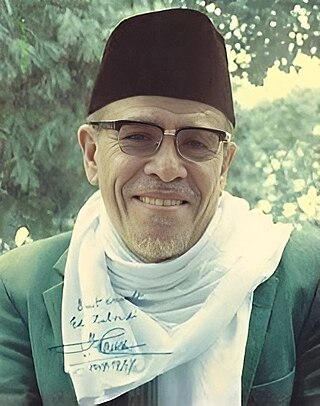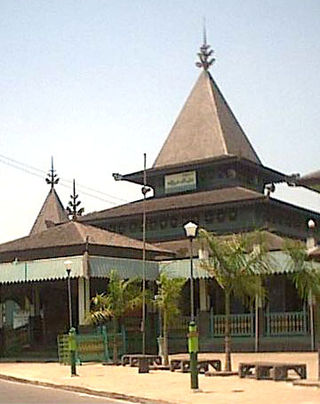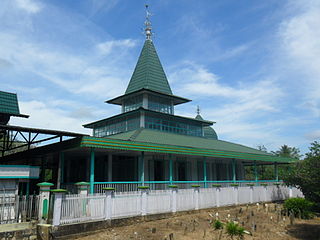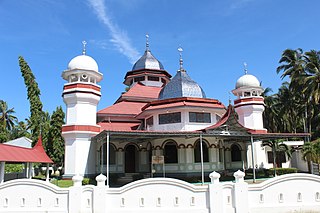
Istiqlal Mosque in Jakarta, Indonesia is the largest mosque in Southeast Asia and the ninth largest mosque in the world in terms of worshipper capacity. Built to commemorate Indonesian independence, this national mosque of Indonesia was named "Istiqlal", an Arabic word for "independence". The mosque was opened to the public on 22 February 1978. Within Jakarta, the mosque is positioned next to Merdeka Square, the Jakarta Cathedral (Catholic), and also of the Immanuel Church (Reformed).

Champaner-Pavagadh Archaeological Park, a UNESCO World Heritage Site, is located in Panchmahal district in Gujarat, India. It is located around the historical city of Champaner, a city which was founded by Vanraj Chavda, the most prominent king of the Chavda Dynasty, in the eighth century. He named it after the name of his friend and general Champa, also known later as Champaraj. The heritage site is studded with forts with bastions starting from the hills of Pavagadh, and extending into the city of Champaner. The park's landscape includes archaeological, historic and living cultural heritage monuments such as chalcolithic sites, a hill fortress of an early Hindu capital, and remains of the 16th-century capital of the state of Gujarat. There are palaces, entrance gates and arches, mosques, tombs and temples, residential complexes, agricultural structures and water installations such as stepwells and tanks, dating from the eighth to the 14th centuries. The Kalika Mata Temple, located on top of the 800 metres (2,600 ft) high Pavagadh Hill, is an important Hindu shrine in the region, attracting large numbers of pilgrims throughout the year.

Banjarbaru is the capital city of South Kalimantan, one of the provinces in Indonesia. It is located 35 km (22 mi) southeast of Banjarmasin, the largest city of the province. The city had a population of 199,627 as of the 2010 Census, and 253,442 at the 2020 Census, and the official population estimate was 272,763. The large town of Martapura lies immediately to the north of Banjarbaru, and in effect constitutes an extension of the city. The second largest city in the province after Banjarmasin, it is also part of Banjarbakula metropolitan area.

Kyai Haji Ahmad Dahlan, often abbreviated to K.H. Ahmad Dahlan, was an Indonesian Muslim religious leader and revivalist, who established the Muhammadiyah organization. Which would become one of the largest Muslim organizations in Indonesia, second only to the Nahdlatul Ulama. Born in Kauman, Yogyakarta, he was the son of an imam of a local mosque and traced his origins from the lineage of Muhammad. Ahmad Dahlan performed the Hajj pilgrimage when he was 15 years old, and he lived in Mecca for another five years.

Abdul Malik Karim Amrullah, better known by his pen name Hamka was an Indonesian ʿālim, philosopher, writer, lecturer, politician and journalist.

Sultan Suriansyah Mosque is the oldest mosque in South Kalimantan. Built in 1526 during the reign of Sultan Suriansyah, the first Banjar King to convert to Islam. The mosque is located in the village of Kuin Utara, in Banjarmasin.
Muhammadiyah University of Makassar, also known as Unismuh Makassar, is a private university located in the city of Makassar, Indonesia. As a private university, Unismuh Makassar is coordinated under Kopertis Wilayah IX, which is a government-funded institution that coordinates private higher education in Indonesia. Unismuh is accredited 'B' based on the National Accreditation Body (BAN-PT).

The Ganting Grand Mosque is a Sunni mosque located in Ganting, Padang, West Sumatra, Indonesia. Construction began in 1805, making it the oldest in Padang and one of the oldest in Indonesia. It is a Cultural Property of Indonesia.

Kasunyatan Mosque is a small mosque in the village of Kasunyatan, Banten, Indonesia. Established between 1570 and 1596, it is one of the oldest mosques in Indonesia. The mosque is located in close proximity to the ruins of Old Banten, and functioned as a 16th-century centre of Islamic study. The mosque received a heritage status during the Dutch colonial period in 1932.

Heritage Mosque of Banua Lawas is an old mosque in Banua Lawas, Tabalong Regency, South Kalimantan. It is one of the oldest mosques in Indonesia. The mosque is also known as Masjid Pasar Arba as there are more pilgrims visiting on Wednesday as it coincides with market day at Banua Lawas. As the oldest mosque in Tabalong regency, in addition to being a place of worship, it is also a milestone and the historical evidence of acceptance of Islam among the Ma'anyan Dayak people in the area.

Al-Markaz Al-Islami Mosque is a mosque located in Makassar, South Sulawesi, Indonesia. The construction begun in 1994 and the mosque was completed in 1996. With maximum capacity of 10,000 pilgrims, building area of 6,932 m2, and site area of 10,000 m2, it serves as one of the biggest centers of Islamic religious activity in Southeast Asia. The building has three floors and made of granite stones, and it faces Masjid Raya Makassar street.

The Syekh Burhanuddin Grand Mosque is one of the oldest mosques as well as a cultural heritage in West Sumatra, Indonesia. The mosque is located in Nagari Ulakan, Ulakan Tapakis sub-district, Padang Pariaman district of West Sumatra.

Bayur Grand Mosque is a mosque located in Nagari Bayur, Tanjung Raya, Agam Regency, West Sumatra, Indonesia. It is not far from the main road connecting Lubuk Basung, the capital city of Agam Regency, and Bukittinggi.

Jami Syekh Abdul Hamid Abulung Mosque, also known as Datu Abulung Mosque is an old mosque in South Kalimantan province, Indonesia, which is located in Sungai Batang village, West Martapura district, Martapura. The mosque was built by the king of Banjar, Sultan Tahmidullah II who ruled the area during 1761 to 1801, as a form of retribution for ordering the executions of Datu Abulung, a scholar who had been accused of heresy. The mosque is one of the cultural heritages in Martapura.
Great Mosque of Riyadusshalihin is a mosque in Barabai, Hulu Sungai Tengah Regency, South Kalimantan Province, Indonesia. The mosque was built in 1962 and it is one of the most important religious and tourist sites in Barabai.

Zheng He Mosque, officially the Islamic Mosque of Mohammed Zheng He in Srivijayan Palembang, is a mosque dedicated to Muslim Chinese people located in Jakabaring Palembang, South Sumatra, Indonesia. The name of the mosque is in honor of the acclaimed Muslim Chinese admiral, Zheng He. The mosque was founded by the initiative of the elders, advisers, and administrators of the Chinese Islamic Association of Indonesia (PITI) of South Sumatra, as well as Chinese community leaders around Palembang. Previously the mosque was led by renowned imam, Ustadz Choirul Rizal, who had memorized 30 juz' from the Quran. Ustadz Miftah who serves as an imam today, is also a hafiz.

An-Nawier Mosque is one of the oldest mosques in Jakarta, Indonesia. It is located in Pekojan, Tambora, a district of Jakarta. The mosque is a symbol of Arab civilization in Jakarta. The mosque's large and ancient architecture stands majestically in one densely populated settlement in West Jakarta. The settlement was once a region whose majority population is descended from Arabs, Yemen and India. Although the number of Arabs is now no longer prominent, but traces can still be found until now in Pekojan.

Indonesia Tokyo Mosque, also known as Meguro Mosque, is a mosque in Meguro, Tokyo, Japan. With the support and the further communication between the Family of Indonesian Islamic Community (KMII) board, the Indonesian Embassy in Tokyo, and the Ministry of Foreign Affairs of Indonesia, the groundbreaking was carried out during the 2015 Eid al-Fitr festival by the incumbent Indonesian Ambassador to Japan, Yusron Ihza Mahendra.

Al-Wustho Mangkunegaran Mosque is a historic mosque located in the Central Javanese city of Surakarta, to the west of the Mangkunegaran Palace. The mosque is one of the three oldest mosques of Surakarta. Al-Wustho Mangkunegaran Mosque was inaugurated as a state mosque of the Mangkunegaran Palace.

Al-Bantani Grand Mosque is a congregational mosque in the city of Serang, Banten, Indonesia. With a capacity of 10,000 pilgrims, it is the second largest mosque in Banten province after the Al-Azhom Grand Mosque.





























